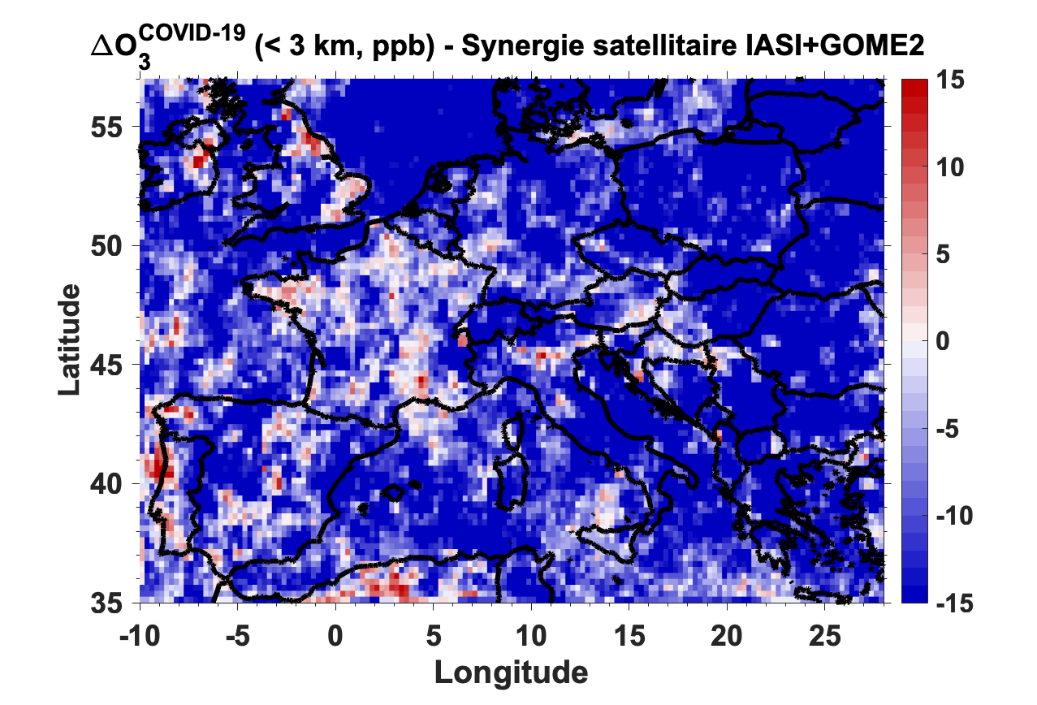Avons nous respiré de l’air plus propre durant le confinement COVID-19?
Did we really breathe cleaner air during the COVID-19 pandemic containment?
The answer is not so simple, even if the reduction of road traffic during the 2020 boreal spring confinement was drastic. Indeed, these human activities induce the direct emission of certain pollutants into the air, such as nitrogen oxides or so-called "primary" particles. The reduction of human activities has indeed greatly reduced the presence of these pollutants.
However, there are other so-called "secondary" pollutants, which are produced chemically in the atmosphere. One example is tropospheric ozone. In this case, the presence or absence of certain atmospheric pollutants can modify both its production and its destruction via chemical processes.
In order to determine whether ozone pollution has increased or decreased in Europe during the spring of 2020, a French team of researchers1 coordinated by the LISA/IPSL laboratory (UPEC / CNRS / Université Paris Cité) has implemented a novel synergy of satellite observations, in situ measurements and chemistry-transport models. This new approach allows us to estimate the evolution of ozone pollution during confinement in an observational way, for the first time from space. It provides an exceptional framework for evaluating the influence of anthropogenic activities and meteorological conditions on model simulations of ozone pollution.
The satellite observations used in the study result from the IASI+GOME22 multispectral approach developed at LISA. They show a large reduction in background ozone pollution, associated with the numerous confinements in the northern hemisphere. On the continent, a reduction in ozone pollution is observed in less urbanized and rural areas, typically characterized by a photochemical regime related to the abundance of nitrogen oxides. However, an increase in ozone pollution is clearly measured in more urbanized areas, especially in Central Europe. This is due to the accumulation of ozone in areas where the sink of this pollutant has been reduced by the reduction of anthropogenic nitric oxide emissions.
These observational estimates of the impact of confinement associated with COVID-19 also show the difficulty of models in estimating its amplitude and vertical extent.

Ozone concentration variations in the very low troposphere (between the surface and 3 km altitude) in Europe in the period 1-15 April 2020 associated with containment to stem the spread of COVID-19. They are estimated by multispectral satellite observations IASI+GOME2, in terms of differences between 2020 and 2019 in the same period and adjusted with the CHIMERE model to get rid of variations associated with meteorological conditions. © LISA/IPSL
En savoir plus
Cuesta J., L. Costantino, M. Beekmann, G. Siour, L. Menut, B. Bessagnet, T. C. Landi, G. Dufour and M. Eremenko, “Ozone pollution during the COVID-19 lockdown in the spring 2020 over Europe, analysed from satellite observations, in situ measurements, and models”, Atmos. Chem. Phys., 22, 4471–4489, https://doi.org/10.5194/acp-22-4471-2022, 2022
Contact
Juan Cuesta
LISA/IPSL
0182392064
This email address is being protected from spambots. You need JavaScript enabled to view it.
1. Les laboratoires et partenaires impliques sont les suivants : Laboratoire Interuniversitaire des Systèmes Atmosphériques (LISA / IPSL, UPEC / CNRS / Université Paris Cité), Centre For Research On Energy And Clean Air (CREA), Laboratoire de Météorologie Dynamique (LMD / IPSL, CNRS / Ecole Polytechnique / ENS / Université Paris-Saclay / SU) et Institute of Atmospheric Sciences and Climate (ISAC-CNR).
2. issues de l’approche dénommée IASI+GOME2 dont le développement et la production bénéficie du soutien financier du CNES et la mise à disposition des données est effectuée par le pôle thématique AERIS. Le PNTS, l’ANR et le CNRS-INSU ont aussi contribué à son développement.

